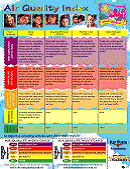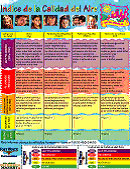
|
 |
 |

Check out our fun interactive games and info for kids!
 |
|
 |
 |
 |
Find
out about Victoria's air quality monitoring and current ozone
levels.
 |
|
|
|
|


Download a detailed Air Quality
Index sheet to keep handy. These files are in PDF and 274kb
each, and available in both English and Spanish.
|

English
|

en español
|
The Air Quality Index (AQI) is a system of quantifying the quality
of the ambient air we breathe. The AQI reading for a given day is
based on the critical pollutants and upon pollutants with high readings.
The major air pollutants used to determine the AQI are ground-level
ozone, particulate matter, carbon monoxide, sulfur dioxide and nitrogen
dioxide.
The Air Quality Index is divided into six categories ranging from
good to hazardous. Good is green, and ranges from 0-50. The next level
is moderate, which is yellow and ranges from 51-100. The third level
is unhealthy for sensitive groups, and is orange. It ranges from 101-150.
The fourth level is unhealthy, which is red and ranges from 151-200.
Very unhealthy is purple, and ranges from 201 to 300. The hazardous
level, rarely seen in the United States, is black and has an AQI of
301+.
Victoria County is recognized as near-nonattainment for ozone, which
means our ground level ozone is dangerously near exceeding the federal
health based recommendations for ground level ozone. Most of the time,
the critical pollutant in our AQI will be ozone. However, sometimes the critical pollutant will
be particulate matter. Particulate matter usually occurs when winds
bring smoke or dust from other regions into our Victoria air. The
following Air Quality Guide illustrates the levels of the AQI, and
the cautionary statements assigned to each level.
| AIR QUALITY GUIDE |
| Air Quality |
AQI |
Caution-Ozone |
Caution
Very Small Particles (PM 2.5) |
| Good |
0
- 50 |
No
health impacts are expected when air quality is in this range.
|
No
health impacts are expected when air quality is in this range. |
| Moderate |
51
- 100 |
Unusually
sensitive people should consider limiting prolonged outdoor
exertion.
|
No
health impacts are expected when air quality is in this range. |
Unhealthy
for
Sensitive Groups |
101
- 150 |
Active
children and adults, and people with respiratory disease, such
as asthma, should limit prolonged outdoor exertion.
|
People
with respiratory disease or heart disease, the elderly, and
children should limit prolonged exertion. |
| Unhealthy
|
151
- 200 |
Active
children and adults, and people with respiratory disease, such
as asthma, should avoid prolonged outdoor exertion; everyone
else, especially children, should limit prolonged outdoor exertion.
|
People
with respiratory disease or heart disease, the elderly, and
children should avoid prolonged exertion; everyone else should
limit prolonged exertion. |
| Very
Unhealthy |
201
- 300 |
Active
children and adults, and people with respiratory disease, such
as asthma, should avoid all outdoor exertion; everyone else,
especially children, should limit outdoor exertion.
|
People
with respiratory disease or heart disease, the elderly, and
children should avoid any outdoor activity; everyone else should
avoid prolonged exertion. |
|
|






